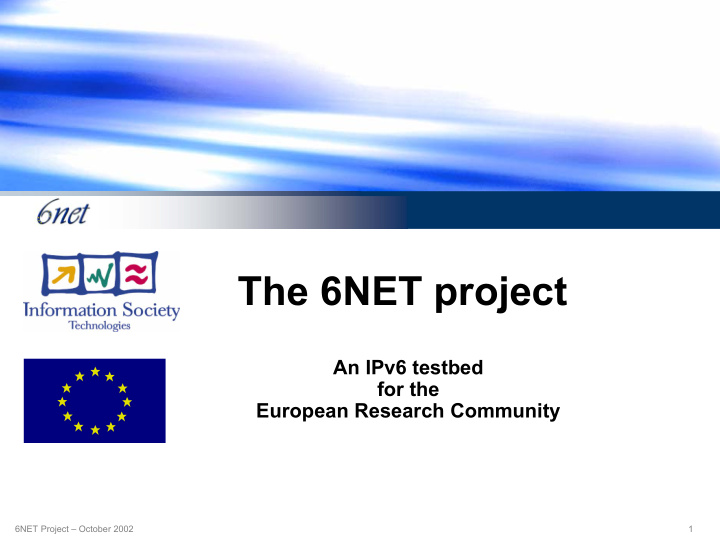



The 6NET project An IPv6 testbed for the European Research Community 6NET Project – October 2002 1
Project Overview • A three-year project to prepare the next generation of the Internet. Started in January 2002. • One of the largest projects in the EC IST Programme, representing a total investment of EUR 18 million (10-11 million EC contribution). • A major international native IPv6 testbed (the largest in the world?) • Objectives: Install and operate a pilot IPv6 network, primarily with native links. Test migration strategies for integrating IPv6 networks with existing IPv4 infrastructure. Introduce and test new IPv6 services and applications, including legacy services and applications. Evaluate address allocation, routing and DNS operation. Collaborate with other IPv6 activities (e.g. Euro6IX) and standardisation bodies (e.g. IETF). Promote IPv6 technology. 6NET Project – May 2003
Partners - Industry 6NET Project – May 2003
Partners - NREN 6NET Project – May 2003
Partners - Academic Research Academic Computer Technology Institute 6NET Project – May 2003
New Partners • 4 new partners joined in September 2003: CESNET, HUNGARNET, PSNC & ETRI • Extended geographical coverage to the Czech Republic, Hungary and Poland (and South Korea). • Will develop open source solutions for running IPv6 (e.g. Combo6, Multicast Beacon). • Create and support public repository of IPv6 software (BSD, Linux and Windows). • Wider dissemination of results in the Newly Associated States. 6NET Project – May 2003
International Native Backbone • 155 Mbps (STM-1) backbone network established. • Interconnections: National IPv6 testbeds (JANET, RENATER, SWITCH etc..) Euro6IX (via UK6X) Abilene (via SURFnet) NTT Japan (via UK6X) ETRI (via RENATER) 6Bone (tunnelled) • 6NET NOC established to handle monitoring, maintenance and fault reporting. • AUP and routing plan established. 6NET Project – May 2003
Core topology Internet2 Internet2 Up and running Japan Internet2 Korea Euro6IX Peering 6NET Project – May 2003
The Layout 6NET Project – May 2003
Co-existence, Interworking and Migration • Investigation of IPv4/IPv6 dual stack operation. • Investigation of IPv6 over MPLS and ATM. • IPv6 tunnelling over IPv4. • Considered IPv6 support for common services (e.g. DNS, Usenet). • Completed surveys of transition tools for core, NREN and university networks. • Native IPv6 was deployed over fixed and wireless networks in Lancaster, Southampton and Tromsø. • Identified ‘missing’ pieces essential to IPv6 deployment. • Published two ‘cookbooks’ for transitioning ISPs and campuses. 6NET Project – May 2003
Basic Network Services • Routing plan defined and implemented. • Set-up DNS support for IPv6. • Multicast overlay established (M6Bone), including multicast beacon. • Set-up and tested IGP (IS-IS) and EGP (BGP+) routing. • Trialled DHCPv6. • Investigated autoconfiguration, service discovery, site local addressing, firewalls and security. • Published ‘cookbooks’ on IPv4 to IPv6 migration for ISPs and campuses. 6NET Project – May 2003
Application and Service Support • Survey and evaluate mobile IPv6 implementations. • Implemented and tested IPv6 over WLAN and cellular networks. • Evaluating access control mechanisms. • Evaluating IPv6 support for QoS. • Investigating various VPN implementations over IPv6. • Investigating IPv6 multihoming and renumbering solutions (summary available). 6NET Project – May 2003
Middleware and User Application Trials • Identified a core set of applications to develop or port to IPv6: Videoconferencing & Streaming (e.g. GnomeMeeting, ISABEL, multicast radio, FreeAMP) Online Gaming (e.g. Quake, XPilot) E-business Solutions (e.g. Globus, OpenLDAP) Edge Services (e.g. proxy caching) • Identifying requirements of specific user communities, and potential users of IPv6. • Will demonstrate applications at end-2003 IPv6 showcase. • Open mailing list for discussing porting issues <porting@6net.org> 6NET Project – May 2003
Network Management Architecture and Tools • Investigating integrated management platforms for IPv6. • Developing support mechanisms for new functions (e.g. autoconfiguration, mobility) • 6NCC established for maintenance planning, fault reporting, failure notification, and propagating network status. • Traffic measurement and visualisation tools developed: Net-SNMP and MRTG for M6Bone IPv6 Traffic Visualisation 6NET Weathermap Smokeping (RRD front-end) • Porting DoS detection and blocking tool. • Conducting IPv6 SNMP tests. • IPv6 Network Management ‘Cookbook’ released. 6NET Project – May 2003
Dissemination • Most results are public and available on 6NET website: http://www.6net.org/publications • Cookbooks (How-Tos) • Quarterly Newsletters (paper and electronic format) • Network topology diagrams • IPv6 Event Calendar • Training Events 6 held during 2002/2003. • Liaison with Euro6IX (interconnectivity, multicasting, VPNs) 6NET Project – May 2003
Planned activities • WP1 – Expansion of the backbone, tests coordination • WP2 – Transition Tools List, Evaluation • WP3 – OSPFv3, IGP-EGP routing optimization, eACLs, 6PE, Multicast, Load Balancing, Network Security • WP4 – Mobility, Wireless, VPN, VoIP, Multihoming, QoS • WP5 – Video, conferencing, Portals, Gaming • WP6 – MIBv6, Netflow • WP7 – 2 x workshops, training courses, publications, publicity events, joint activities with Euro6IX, liaison with other groups (IPv6 Cluster, IPv6 Task Force, TF-NGN) 6NET Project – May 2003
Recommend
More recommend